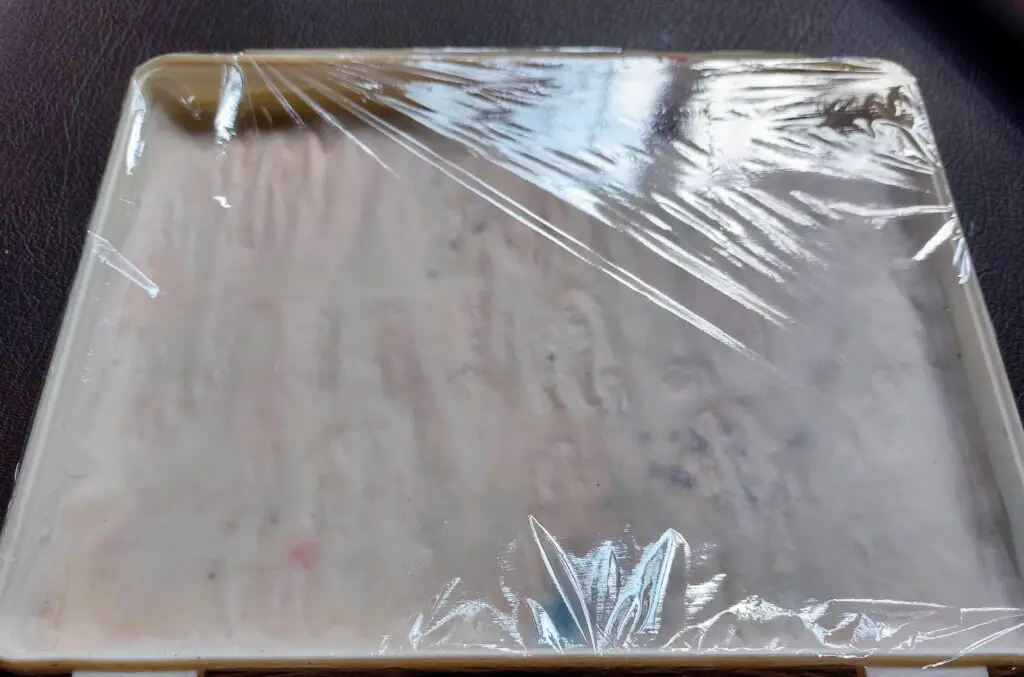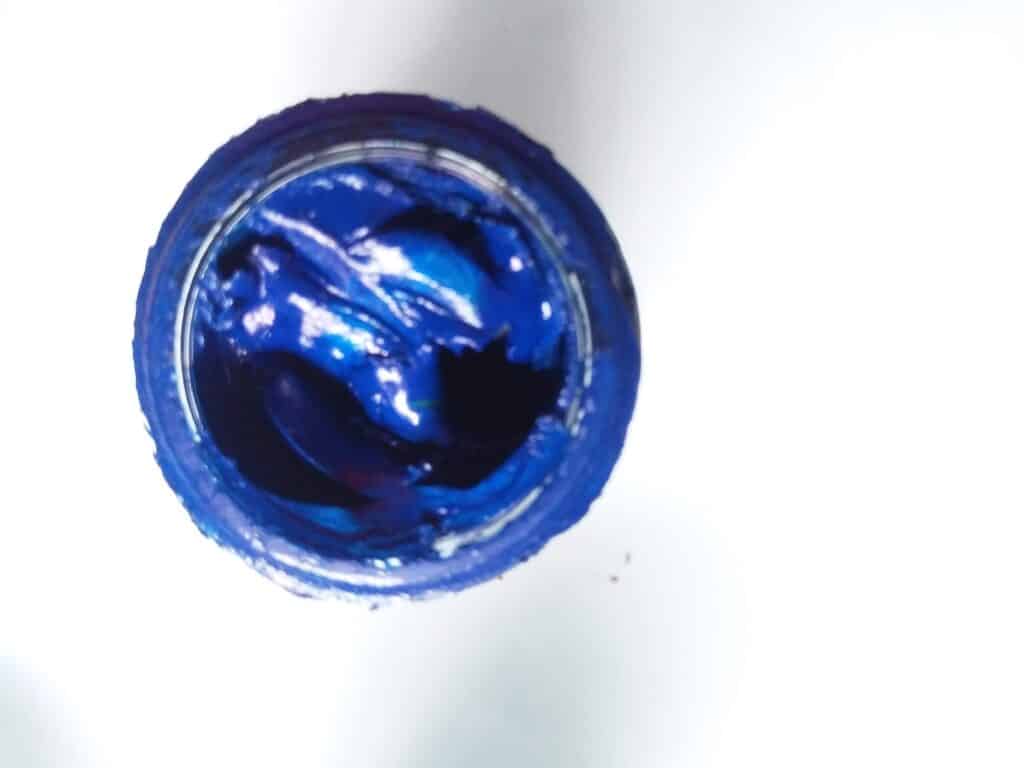Acrylic paint can be quite expensive, especially artist-grade acrylics. Therefore saving acrylic paint as much as possible won’t break the bank. There are a few things you need to follow to save acrylic paint for reuse.
Acrylic paint can be saved by increasing the drying time by increasing the humidity, lowering the temperature, and lowering airflow. Special formulas such as acrylic paint retarders, interactive acrylics, and OPEN acrylics slow down the drying time.
Other than increasing the drying time or workable time of acrylic paint, there are a few tactics you can follow to save acrylic paint like using a limited color palette.
11 Best ways to save acrylic paint to reuse
There are many ways to save acrylic paint for reuse. Most of them focus on increasing the drying time of acrylic paint until its next use by using special formulas and controlling environmental factors. Preventing acrylic paint from going bad, or activating dried acrylic paint also saves much paint.
The fast-drying nature of acrylic paint is what makes us lose more paint and why we need to learn about saving acrylic paint. Saving acrylic paint will be the best way to continue your passion for art without breaking the bank. Below I have included the 11 best ways of saving acrylic paint that will save you a fortune.
1. Use a stay-wet palette to keep the paint wet
I recommend a stay-wet palette for any acrylic artist. Because it helps to keep the paint wet overnight, for days and even weeks. A stay-wet palette will always save you acrylic paint, without drying on you after a few minutes.
There are commercially available stay-wet palettes. But I do not see why you need to buy a stay-wet palette which is quite expensive while you can make your own for free. A DIY stay-wet palette always worked for me and it kept my paint mixtures wet and workable for days and even weeks.
I always suggest you spend your good money on quality pigments/artist-grade acrylic paint which are expensive but always worth the price.
To make your DIY stay wet palette you will need an empty tray (preferably with a lid), paper towels, and a baking sheet or parchment paper. Take the tray and line a few layers of paper towel on the tray. Then soak the paper towels with water. Then drain out the excess water on the palette. Lay a baking sheet cut out to the size of the baking tray on top of the wet paper towels.

Now you can start painting. Put out the acrylic paint colors onto the baking sheet of stay wet palette. You can even mix colors with a brush and carefully with a palette knife on the stay-wet palette. This way you can keep your acrylic paint mixers the next day you paint.
After a painting session, close the stay-wet palette with its lid. If the tray did not come with a lid you can cover it with plastic wrap. That is how I close my stay-wet palette. If you keep paint on the stay wet palette for a long time, you will begin to see, fungus growth. This can be pretty annoying.


To avoid fungus growth you can mix Dettol, hydrogen peroxide, or vinegar with the water used for the stay-wet palette. My preferred way is mixing water with Dettol which is a disinfectant. It can keep the paint without mold and mildew for about a week.
Always keep an eye on the water level of the stay-wet palette. The paper towels of the stay-wet palette need to be well soaked but not drowning in water. If you close the lid with excess moisture in the palette it will make the paint watery and unusable.
Also if the stay wet palette paper towels become dry after a painting session lift the baking sheet and soak the paper towels again with some water.
2. Keep paint in a closed container to prevent drying
Other than a stay-wet palette you can use a closed container to trap moisture and paint. This way paint will not dry for a long time even though there are no wet paper towels or sponges in the container. You will be able to keep acrylic paint wet for a few days in a closed container.
The closed container is mainly a storage method for acrylic paint. It is not suitable for mixing acrylic paint. Because paint can dry while the container is open and mixing colors.
There are a few ways you can use a closed container to store acrylic paint. You can get a jewelry organizer box with a lid that has several cells. You can store acrylic paint in each cell separately. Mist a little water on the paint and close the container. This could keep acrylic paint wet overnight and may be for a few days.

Alternatively, if you are mixing acrylic paint on a palette, you can keep the whole palette with leftover acrylic paint, inside a closed container. To keep the environment inside the container moist, you can keep a wet sponge inside the closed container near the palette.

You can even use small plastic containers to store different colors separately. Any place where you can keep acrylic paint in a closed environment would work. Keeping acrylic paint wet and workable inside a closed container can save acrylic paint for the next day or several coming days.
3. Use a limited color palette or only necessary colors
You can save acrylic paint by using a limited color palette. This means you can create any beautiful acrylic painting with only a few colors. This will not only save more acrylic paint but also will save you a lot of money as you can mix more colors than buying separate paint tubes.
You can create most of the artwork by using the following colors.
- Cadmium yellow medium (warm yellow)
- Cadmium Lemon (cool yellow)
- Ultramarine blue (warm blue)
- Phthalo blue (cool blue)
- Cadmium red or pyrrole red (warm red)
- Permanent Alizarin Crimson (cool dark red)
- Titanium white (Neutral)
- Yellow Ochre (optional)
Start with this color palette and you can add a few more colors to your palette later, according to your needs. If you want to learn how to mix any color you want with this limited color palette you can read my article: Acrylic paint color mixing chart (with free downloadable). You will find a downloadable acrylic color mixing chart and color mixing video guide there.
4. Only take out the necessary amount of paint
When painting it is best if you can take out only the necessary amount of paint onto the palette. Because acrylic paint tends to dry out quickly and you will waste a lot of paint by taking out more paint than you need. Practice this even if you are using a stay-wet palette because the paint will dry at any point.
If you are using artist-grade paint which is expensive, do not waste paint by putting out more. However, in general, you will need more paint than you think.
5. Use a water mister to keep acrylic paint wet for long
Water is what keeps acrylic paint from drying. It keeps acrylic paint workable for a long time. You can use a spray bottle to spray water on the acrylic paint palette from time to time. This will keep acrylic paint moist. A micro mister that mists water is best as it will apply only a little water uniformly.
You can use the same mister to keep the stay-wet palette wet as well. Mister can be used to spray the back of the canvas with water to blend colors better. It will also keep acrylic paint on canvas moist and workable for a long time.
6. Use acrylic paint retarders or slow dry mediums
Retarders come as additives for acrylic paint to extend the qualities of acrylic paint. Golden acrylic paint retarder is one of the best on the market. It is made primarily from propylene glycol which is a synthetic liquid substance that absorbs or expels water (source). Hence the water evaporation rate is reduced.
Therefore a retarder can increase the time an artist can manipulate or work with acrylic paint. This helps artists to make acrylic paint more bearable and save acrylic paint at the same time. If enough water leaves the acrylic paint film, the paint will not be easily workable in the artist’s favor.
Use the retarder according to the manufactures recommendations. The Golden acrylic paint retarder can be used as 1 part retarder to 7 parts paint which is about 15% addition of retarder to acrylic paint. This ratio is important as it will not alter the original opacity of acrylic paint. It will increase the drying time up to 24 minutes (source).

You can increase the amount of retarder added but always keep the amount of retarder less than acrylic paint. Then it will not make acrylic paint more transparent. But the drying time will increase by more than 24 minutes.
Other than using acrylic paint retarders, you can use slow dry mediums with acrylic paint. Winsor & Newton and Liquitex have Slow Dri acrylic mediums. Winsor & Newton acrylic retarder said to increase the working time of acrylic paint 3 times while Slow Dri medium of Liquitex increases the open time by 40%.
Slow dry mediums usually increase the transparency of acrylic paint, while Slow dry fluid additives or acrylic paint retarder additives do not change the transparency of paint if used in the correct ratio. So I recommend you to use a retarder fluid additive rather than a medium such as Golden acrylic retarder.
7. Use OPEN Acrylics to keep acrylic paint workable
OPEN slow-drying acrylic paint is the extended version of normal acrylic paints. It has a high open time/ working time which allows the artists to paint wonderful portraits, and landscapes using glazing, shading, softening, and fine detailing, techniques just like oil paints.
To maintain the maximum open time of OPEN acrylics, use Open medium, gel, and thinner. OPEN acrylics can be kept wet for 30 to 60 minutes and workable for around 12 hours after opening (source).
The OPEN acrylic formulation is very similar to that of Golden acrylic paint except for the incorporation of humectants. Humectants just as in acrylic paint retarders, absorb water and retard acrylic paint drying.
As OPEN acrylics dries slowly and have a long open time, we can use OPEN acrylics to save more paint. Moreover, it will give most properties of oil paints that were missing before in acrylic paints.
8. Use interactive acrylics to keep acrylic paint workable
Interactive acrylics is a new acrylic paint formula developed by Chroma Atelier taking acrylic paint a step ahead. Interactive acrylic paint can be reactivated even after drying with a special unlocking formula which is also produced by the company.
It gives you plenty of time to blend colors and reactivate already-dried acrylic paint. Use atelier mediums to extend the drying time. This is because interactive acrylics do not immediately form a skin.
Since colors are workable even after days, you do not have to waste excess acrylic paint to do the touchups or blending after the paint layers are dry. Using innovative acrylic paint like Chroma interactive acrylic paint will save you more.
The colors when dry do not have the traditional plastic-like finish of acrylic paint. Instead, it has a satin-like finish closer to oil paint. These Atelier acrylic colors give more control over acrylic paint when used with their mediums and special formulas like unlocking formulas.
If you do not have an unlocking formula as it is more expensive or what so ever, you can use rubbing alcohol/ isopropyl alcohol as the unlocking formula. It works the very same as Atelier acrylic unlocking formula.
9. Prevent acrylic paint from going bad
Preventing acrylic paint from going bad is one of the major aspects of saving acrylic paint. You can prevent acrylic paint from going bad by maintaining proper storage conditions, limiting the chance of contamination, and reducing air exposure to acrylic paint. You can learn this thing in detail by reading my article ‘How long does acrylic paint last? All you need to know.

The ideal storage condition for acrylic paint would be 70oF (21ºC)to 85oF(29.4ºC) and never below 32oF (10ºC)and above 90oF (32ºC), and relative humidity 75% or lower (50%) and never above 85%. To limit contamination always take out paint into the palette and use it rather than putting the paintbrush into the paint container.
Air exposure to acrylic paint containers needs to be reduced. This way acrylic paint will not dry out and waste paint. You need to keep the acrylic paint containers airtight to prevent them from drying out. Always clean the caps of acrylic paint containers to close them well.
10. Control influencing factors to increase dry time
If you can keep acrylic paint from drying for a long time you can save more paint. In this case, you can control some of the environmental factors, contributing to drying acrylic paint. These are temperature, airflow, humidity, and surface absorbency.
Hot temperature accelerates drying while cold temperature slows down the drying time. However, do not go to extreme temperatures on either end. Because it can cause defects in the acrylic paint film. The ideal temperature would be around 70 to 90oF. The temperature should never be below 49oF (9oC) as it does not form a stable paint film.
I have seen some sources on the internet suggest freezing leftover acrylic paint to prevent it from drying. Golden acrylic recommends storing acrylic paint in its original container between 60 – 75 oF (15.5 – 23.8oC).
However, keeping leftover acrylic paint in the fridge until the next painting session will not harm you as it is not the whole paint tube that you keep in the refrigerator. But, there is a better way to control the drying time than cold temperatures. It is humidity.
If the humidity is more than 70 – 75% it will slow down the drying process by slowing the evaporation of water. Controlling humidity is a better way to control drying time than temperature. If the studio is very dry you can increase the humidity with a humidifier.
That is the principle behind a stay-wet palette, water mister, and keeping acrylic paint in a closed container. All these methods increase humidity in acrylic paint containers and slow drying.
The airflow should be moderate and steady to dry acrylic paint better. To increase the drying time you can reduce the airflow by turning off a fan if there is one. The lower the airflow slower the drying process would be and you could save more acrylic paint.
If you are painting on an absorbent surface like paper the paint will dry quickly, by absorbing water into the paper. But if you seal the paper with an acrylic gloss medium before painting, the paint will stay wet for longer on the surface, as the surface has less moisture absorbance.
11. Reactivate dried acrylic paint with water or alcohol
Acrylic paint normally cannot be reactivated once the skin is formed and started drying. However, you can follow some tips and tricks to rehydrate or reactivate dried acrylic paint. This will be the ultimate way of saving acrylic paint, as most other methods have mentioned preventing acrylic paint from drying quickly.

You can reactivate acrylic paint after drying but it will be a little harder. First, check if the paint has some moisture left over. If there is moisture left, start adding water a few drops at a time, and mix well. This way dried acrylic paint will be activated and become a liquid that is usable again.
You can also mix alcohol with dried acrylic paint to reactivate. However, it will not help with acrylic film formation. If the acrylic paint is very old and no water left in it, it cannot be reactivated.
I have written a whole article about ‘How to reactivate dried acrylic paint? (Is it possible?)‘. You will find more details on reactivating acrylic paint, as well as what not to do when reactivating acrylic paint.
Conclusion
Acrylic paint’s short drying time is one of the key characteristics of acrylic paint. However, it is the same aspect of acrylic paint some artists love but have a hard time dealing with. Acrylic paint has less working time and bendability as it dries quickly. This will waste so much paint. But if we know how to be conservative with acrylic paint and how to slow the drying process of acrylic paint, it is easy to save more acrylic paint for the next use.

